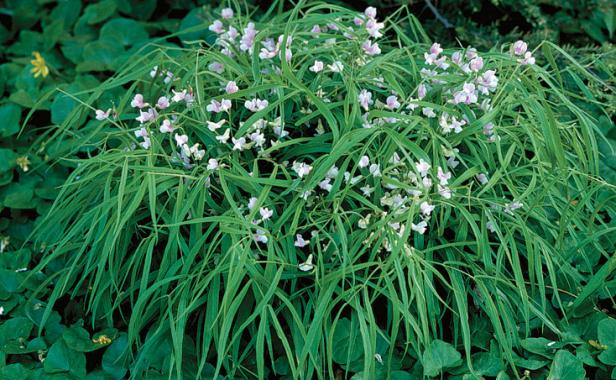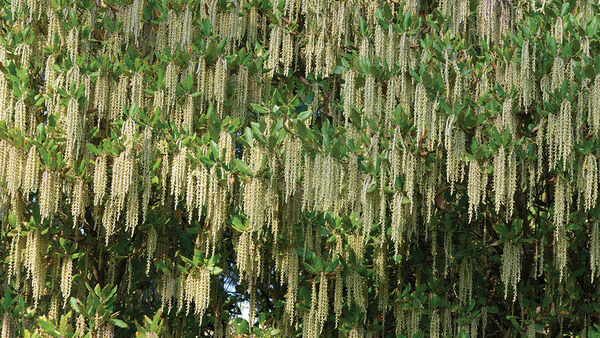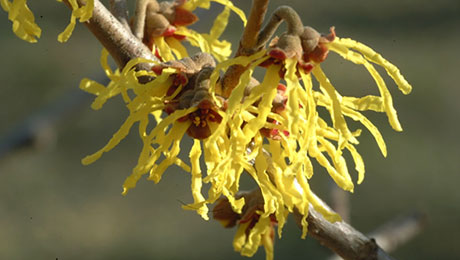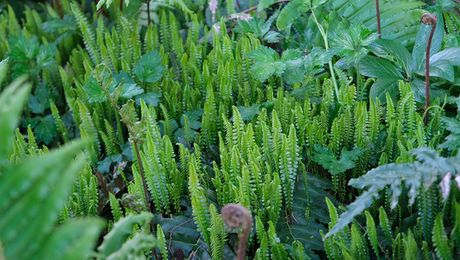
In many parts of the world, the extremely short period between the melting of the last bits of snow and the first waves of heat is, by far, the most intense and thrilling time of the year. As a youth, I endured lengthy winters in the Quebec countryside, where my only solace was the plant catalogs I received in the mail, fueling my longing for spring. The May frenzy I would eventually put myself through didn’t help my reputation as an odd, slightly challenged child. I have since settled on the milder West Coast, where a much calmer spring gently rolls in as the holidays are left behind, peaks over a couple of months, and then seamlessly merges into summer.
Wherever spring is anxiously awaited, early-flowering perennials can be trusted for a colorful celebration. Some spring bloomers are long-lasting, putting on a show for months on end, while others are ephemeral, leaving us almost as quickly as they came. No matter how long they last, each of the following spring bloomers deserves a spot in your garden. These are a few of my favorite vernal gems, sure to infuse life into the garden after the winter finally melts away.
Early-flowering options start the party off

Name: ‘Père David’ blue corydalis
Zones: 6–8
Size: 12 inches tall and wide
Conditions: Partial shade; moist, well-drained soil
Staying power: Long-lasting in cool areas; goes dormant in hot, dry conditions
Nothing signals the end of a barren winter like the splash of electric blue provided by ‘Père David’ blue corydalis (Corydalis flexuosa ‘Père David’). Native to the mountain wilds of western China, this delicate-looking plant has masses of narrow, tubular flowers that are reminiscent of wingless, ethereal blue dragonflies. While it resents overheating and going dry, which throw it into temporary dormancy, blue corydalis has proven surprisingly hardy and forgiving. It has fibrous roots that will gently creep away to embrace whatever lucky neighbors it has. Graced by delicate, lacy foliage, ‘Père David’ will continue to bloom from early spring well into summer and again in fall, given that springlike conditions prevail.

Name: ‘Crimson Fans’ mukdenia
Zones: 7–9
Size: 14 inches tall and 16 inches wide
Conditions: Full sun to partial shade; moist, well-drained soil
Staying power: Lasts all season; goes dormant in fall
Another selection that has multiseason appeal is mukdenia, which thrives in rich soil and under the coldest skies without much fuss. Its squat, maple-shaped leaves are a fresh, glossy green. Dense constellations of starry white flowers, however, steal the show, making a statement above the just-emerging foliage in early spring. Among a handful of tempting selections is ‘Crimson Fans’ mukdenia (Mukdenia rossii ‘Crimson Fans’, syn. ‘Karasuba’). This cultivar is especially great for the tendency of its foliage to redden as temperatures rise, holding this hue until the close of the season.

Name: Rigid spurge
Zones: 7–11
Size: 12 to 24 inches tall and wide
Conditions: Full sun; well-drained soil
Staying power: Evergreen
Rigid spurge (Euphorbia rigida) is also an early-spring standout with interesting foliage. This unique-looking plant grows into a knee-high, rounded specimen. It is cloaked with slender, pointed, grayish blue leaves, all neatly set along stiff stems. The somewhat quiet flowers are nestled among much larger chartreuse bracts, for a lasting, electrifying display; this arrangement isn’t too far from the festive poinsettia, a family relative. While this spurge could technically marry with early bulbs for an exotic-looking but functional pairing, a more natural match would be with other mates that like dry conditions, such as agaves (Agave spp. and cvs., Zones 9–11).

Name: Gibraltar candytuft
Zones: 5–9
Size: 6 to 12 inches tall and 18 inches wide
Conditions: Full sun; well-drained, lean soil
Staying power: Stays evergreen in warmer zones; goes dormant in fall in cooler zones
Although native to northern Africa, Gibraltar candytuft (Iberis gibraltarica) is hardy enough for a fair number of gardens on this continent. It is a short subshrub with rosettes of wedge-shaped, medium green leaves. Compared to the traditional candytuft, this beefy species offers a decadent flower display. In midspring, the whole plant disappears under an abundance of flat, light violet to pinkish white blossoms, creating a lasting mound of color. Follow a lean-and-mean regimen because Gibraltar candytuft tends to thrive in poor, dry soils with little or no fertilization. This low-maintenance approach will encourage tight growth and optimal flowering. Like most candytufts, a severe haircut in the wake of its blossoming is mandatory to prevent it from getting too leggy.
Be ready with an ephemeral action plan
The rapidity of some spring bloomers to enliven our still-frozen lives is oftentimes matched only by their prompt exit. These disappearing perennials are called “ephemeral” for their short but sweet presence in the garden. As they fall into dormancy, these plants sometimes leave a hole in the all-too-young fabric of our garden. The best way to avoid this eyesore is by planting late-emerging bedmates. The dwarf larkspur, trillium, and corydalis should, therefore, be surrounded by perennials such as hostas, ferns, and ornamental grasses. These companions cover up all traces of our dear ephemerals and protect them from our accidental poking and digging.

Name: ‘Flaccidus’ spring vetch
Zones: 4–9
Size: 12 inches tall and wide
Conditions: Partial shade; moist, well-drained soil
Staying power: Lasts all spring; goes dormant in mid to late summer with dry conditions.
Contrary to its better-known vining siblings, ‘Flaccidus’ spring vetch (Lathyrus vernus ‘Flaccidus’) is a perennial pea that forms a bushy mound of refined foliage. It is mostly for its early, enduring blossoming that this particular cultivar is sought after. A slow grower, ‘Flaccidus’ has narrow leaves that create a handsome, feathery look. Small but numerous flowers open pale magenta-pink and gradually fade to a violet-blue. This plant, with its abundant blooms, opens the vernal ball at the start of spring but also takes part in the last dance, providing some of the last twirls of spring color.

Name: Dwarf larkspur
Zones: 4–8
Size: 18 to 24 inches tall and wide
Conditions: Partial to full shade; moist, well-drained soil
Staying power: Disappears in late spring
With the cornucopia of hybridized delphiniums out there—as impressive as they are high maintenance—don’t be tempted to dismiss the native species. Dwarf larkspur (Delphinium tricorne) is one of those shy creatures, native to the woods of eastern and central North America. From its stylishly dissected foliage towers a solid, foot-long raceme of well-spaced flowers. In shades of violet to blue or (rarely) white, each flower is adorned on its back with a long, distinctive curved spur. As with most delphiniums, this larkspur is toxic if eaten and should be kept away from children. It tends to produce abundant seeds, which can be entrusted to serendipity or agile hands, with good chances of sowing success.
Late-blooming selections keep the frenzy going

Name: ‘Flore Pleno’ great white trillium
Zones: 3–8
Size: 16 inches tall and 12 inches wide
Conditions: Partial to full shade; rich, moist, well-drained soil
Staying power: Lasts all spring; goes dormant in early to midsummer
Graced by large, three-part flowers, trilliums are truly an arresting sight. The double-flowered cultivars, consisting of multiple layers of petals, resemble little roses more than trilliums. A few different forms are known, including the beautiful ‘Flore Pleno’ great white trillium (Trillium grandiflorum ‘Flore Pleno’). Each cultivar differs in the exact arrangement of its petals. Because it is sterile, divisions of this plant always command large sums, and it takes a long time to obtain that sturdy, traffic-stopping clump. But trust me—this plant is worth it.
Showers of more spring flowers



1. Snowmass® sand phlox, Zones 4–8, Full sun (Phlox bifida Snowmass®)
2. Asiatic twinleaf, Zones 5–8, Partial to full shade (Jeffersonia dubia)
3. Glaucidium, Zones 6–9, Partial to full shade (Glaucidium palmatum)
4. ‘Oscar Schoaf’ rue anemone, Zones 4–7, Partial shade (Anemonella thalictroides ‘Oscar Schoaf’)
5. Golden saxifrage, Zones 6–8, Partial to full shade (Chrysosplenium davidianum)
6. ‘Mrs. Betty Ranicar’ hellebore, Zones 6–9, Full sun to partial shade (Helleborus × hybridus ‘Mrs. Betty Ranicar’)
7. Western columbine, Zones 4–7, Full sun to partial shade (Aquilegia formosa)
8. ‘Californian Skies’ blue-eyed grass, Zones 6–8, Full sun to partial shade (Sisyrinchium ‘Californian Skies’)
9. ‘Purple Heart’ epimedium, Zones 5–9, Partial shade (Epimedium × youngianum ‘Purple Heart’)
10. Japanese cobra lily, Zones 6–9, Partial shade (Arisaema ringens)
11. Large-flowered merrybells, Zones 3–7, Partial to full shade (Uvularia grandiflora)
12. Bird’s-foot violet, Zones 4–8, Full sun to partial shade (Viola pedata)

Name: ‘Canyon Snow’ Pacific Coast hybrid iris
Zones: 7–9
Size: 12 to 18 inches tall and wide
Conditions: Full sun to partial shade; well-drained soil
Staying power: Evergreen
California has a wealth of native irises that burst into color as temperatures rise. Breeders have been busy creating garden varieties collectively known as the Pacific Coast hybrid irises; among this lot, ‘Canyon Snow’ Pacific Coast hybrid iris (Iris ‘Canyon Snow’) stands out. Prized for its pure white flowers elegantly marked with gold, ‘Canyon Snow’ is among the most dependable and floriferous selections available. This iris sports a loose, durable clump of coarse, grassy, dark green foliage. It flushes new growth when the rains return in fall and will start blooming as soon as days lengthen in late spring. It is ideal for nearly any garden setting.

Name: ‘Elise Fellmann’ snowdrop windflower
Zones: 3–9
Size: 12 to 16 inches tall and wide
Conditions: Full sun to partial shade; moist, well-drained soil
Staying power: Lasts all season; goes dormant in fall
One of the few plants I’ve cherished since my late teens is the double-flowered ‘Elise Fellmann’ snowdrop windflower (Anemone sylvestris ‘Elise Fellmann’). It produces cream-colored pompons that would put any dandelion to shame. These blooms are marked by the softest touch of green in their center and last much longer than other windflowers. A lacy robe of small, finely cut leaves surrounds the base of the plant. While other windflowers prove a little too vigorous for some gardeners, ‘Elise Fellmann’ has much better manners. A well-established clump can perform its bloom extravaganza for well over a month and repeat the exploit in early fall.
Fine Gardening Recommended Products

Planting in a Post-Wild World: Designing Plant Communities for Resilient Landscapes
Fine Gardening receives a commission for items purchased through links on this site, including Amazon Associates and other affiliate advertising programs.

Lee Valley Garden Knife
Fine Gardening receives a commission for items purchased through links on this site, including Amazon Associates and other affiliate advertising programs.

Gardener's Supply Company Summerweight Fabric Plant Cover
Fine Gardening receives a commission for items purchased through links on this site, including Amazon Associates and other affiliate advertising programs.



















Comments
Log in or create an account to post a comment.
Sign up Log in